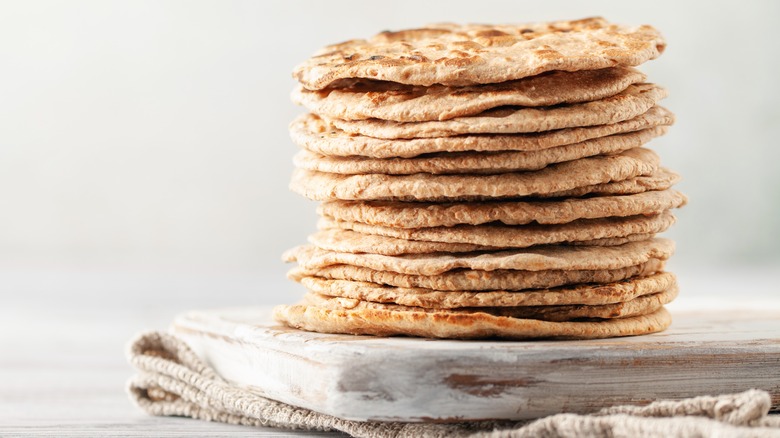The Ancient Origins Of Traditional Flatbread
Flatbreads appear in regional cuisines the world over. They may serve as a meal on their own, a side dish, or a vessel for other foods. For many in the United States, the most familiar examples will be Mexican tortillas, Greek pita, and Indian naan, but these barely scratch the surface of the flatbread universe. South Asia is home to roti and chapati, whole wheat flatbreads used to dip in stews and curries. In Ethiopia, sour injera bread serves as the base of nearly every meal, acting as a sort of edible platter with multiple dishes piled on top. On the Italian island of Sardinia, you'll find pane carasau, which is so thin and crunchy that locals sometimes refer to it as "carta musica," meaning "music paper." It would take multiple lifetimes to sample them all.
Flatbreads can generally be grouped into two categories. The first is leavened flatbread, made with some type of rising agent such as yeast or sourdough starter. A similar effect can also be achieved by fermenting the dough. Examples of leavened flatbreads include the aforementioned naan as well as Italian focaccia. On the flip side, you have unleavened flatbreads, which typically contain nothing more than flour, water, and salt. Examples include tortillas, chapati, and the Passover staple of matzo. Both types can be traced back centuries, but it's unleavened flatbreads that take us to the furthest reaches of history. Some believe that these breads were the very first examples of processed food.
The first breads were flat
Before we proceed, a quick note about the term "processed food": These days, it evokes industrialization — foods like American cheese slices and Spam that bear concerning nutrition labels. Technically speaking, processed food simply refers to any food that undergoes some alteration from its natural state. Food historians argue that flatbread should be considered the original processed meal because it marks the first instance of human technology being used to drastically alter the physical state of a foodstuff. The exact origin of flatbread is difficult to pinpoint, but some theorize that human beings initially combined grains and water to make gruel, and at some point, an enterprising individual decided to dump their gruel on a heated rock, creating the first flatbread.
Many archaeologists credit the invention of flatbread to a group called the Natufians, who inhabited the Levant region between 12,500 and 9,000 B.C. The Natufians are widely regarded as the first agricultural society, marking the beginning of humanity's transition from exclusively hunter-gatherer cultures to farmers exercising broad control over their food supply. Flatbread likely played a significant role in this process, and bread grains are considered the very first examples of domesticated plants. Bread was, as it is now, a laborious thing to make, and it's likely that the Natufians consumed it on special occasions rather than as a staple food. Bread's role as a staple, as well as the development of leavened breads, emerged thousands of years later.
Flatbreads fueled the ancient world
Roughly 5,000 years after the Natufians made the first flatbreads, three civilizations rose to power that would have unprecedented effects on the course of human history. These were the ancient Egyptians, the Mesopotamians (of present-day Iraq), and the Harappans (of the Indus Valley in present-day Pakistan). All three relied on bread as a dietary cornerstone, and the technological advancements they made brought bread much closer to its modern state than the initial flatbreads of the Natufians. The first major development was the invention of leavened bread, which can be traced to ancient Egypt around 1,000 B.C. Interestingly enough, bread was likely not the first foodstuff to use yeast; That honor goes to beer. Many believe that the invention of leavened bread was a happy accident, occurring when an ancient individual spilled yeasty beer in their flatbread dough.
Yeast was one of two developments necessary to make leavened bread, the other being the spacious, domed ovens that emerged during the Bronze Age. The earliest flatbreads would have been grilled, much like tortillas are made to this day, but the oven allowed the bread to cook from all sides, paving the way for the taller loaves we know today. Still, flatbreads, especially the unleavened varieties, had distinct advantages that remain relevant to this day. They can be made from just about any type of starch, including pseudocereals like buckwheat and quinoa and even legumes. The versatility and simplicity of flatbreads make them ideal starting points for novice bakers.


